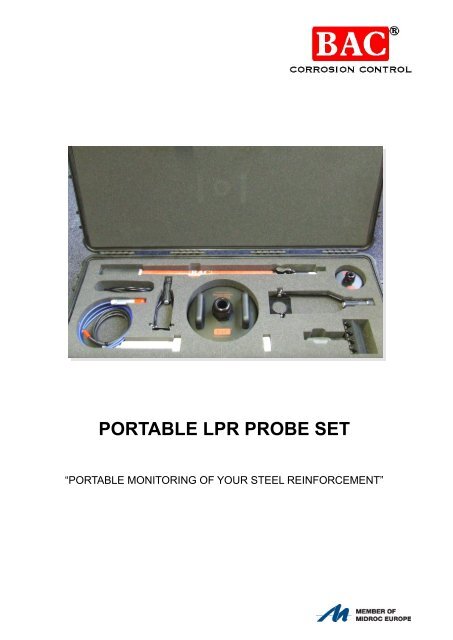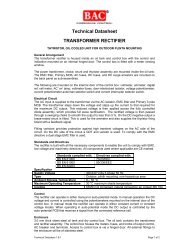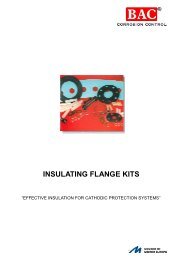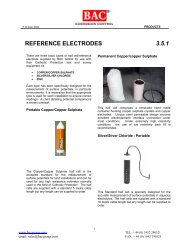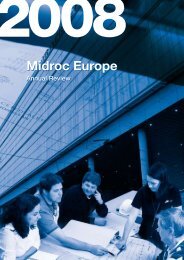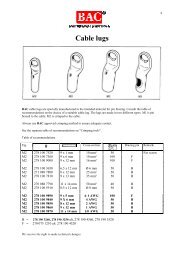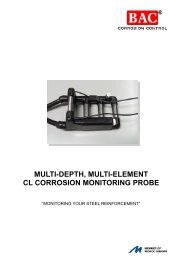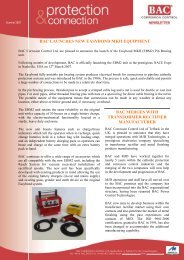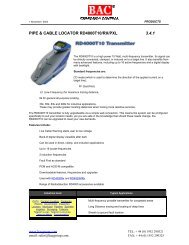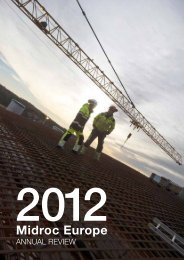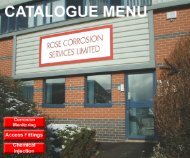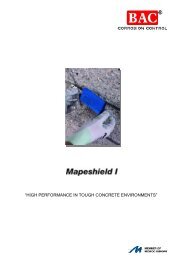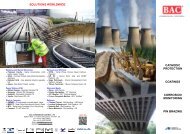Portable LPR Probe Set Brochure - BAC Corrosion Control Ltd
Portable LPR Probe Set Brochure - BAC Corrosion Control Ltd
Portable LPR Probe Set Brochure - BAC Corrosion Control Ltd
You also want an ePaper? Increase the reach of your titles
YUMPU automatically turns print PDFs into web optimized ePapers that Google loves.
PORTABLE <strong>LPR</strong> PROBE SET<br />
“PORTABLE MONITORING OF YOUR STEEL REINFORCEMENT”
Introduction<br />
„Bigfoot‟ and „Littlefoot‟ surface mounted probes were developed to provide<br />
assessment information on the corrosion condition of steel reinforcement by<br />
supplementing traditional surface mapping corrosion potential surveys.<br />
Theory of Operation<br />
<strong>Corrosion</strong> potential surveys using Silver/Silver Chloride (Ag/AgCl) and Copper/<br />
Copper Sulphate (Cu/CuSO 4 ) reference electrodes provide limited information easily<br />
influenced by differing salt content, moisture content and temperature within the<br />
concrete. <strong>Corrosion</strong> potential results are often assessed against comparative tables<br />
provided in a number of technical publications, including those in ASTM C876 which<br />
suggest that steel potentials more negative than -0.300V against Ag/AgCl indicate<br />
corrosion activity. However, it is now well understood that wet or even moist<br />
concrete can limit oxygen availability to the steel, which can lower steel corrosion<br />
potentials, sometimes to -0.700V or more negative against Ag/AgCl, even though<br />
corrosion activity is not increased significantly.<br />
Carrying out surface Linear Polarisation Resistance (<strong>LPR</strong>) corrosion rate surveys<br />
provides an estimate of both the corrosion potential and corrosion rate at the time of<br />
testing. These two parameters can be analysed or mapped onto contour maps.<br />
Correlation between the corrosion potentials and the corrosion rates generally<br />
increases confidence levels in condition assessment.<br />
<strong>BAC</strong> Equipment<br />
The <strong>BAC</strong> corrosion rate system using hand held <strong>LPR</strong> meters and „Bigfoot‟ or<br />
„Littlefoot‟ probes provides both sets of data simultaneously. Readings taken on a<br />
grid formation usually take some 30-90s at each reading site. The meter records<br />
and provides a visual readout; date, time, corrosion potential & corrosion rate (in<br />
terms of µm/yr loss of metal per 100cm²). If the approximate size and spacing of the<br />
steel reinforcement is known then the estimated steel corrosion rates can be<br />
calculated and plotted or recorded.<br />
Resistivity<br />
<strong>Probe</strong><br />
Ag/AgCl Reference<br />
Electrodes<br />
Underside of the „Bigfoot‟<br />
probe
Kit Composition<br />
Bigfoot and Littlefoot surface corrosion monitoring probes comprise a rigid<br />
non-metallic body form, a conductive foam auxiliary electrode, a removable Ag/AgCl<br />
reference electrode and a flying lead connection to the steel enabling<br />
three-electrode <strong>LPR</strong> corrosion rate measurements to be taken at each test site.<br />
With a trailing test lead connected to the electrically continuous steel reinforcement,<br />
the probe is held against the concrete surface in a grid formation. The <strong>LPR</strong> meter<br />
carries out testing at each node point, recording the steel corrosion potential (mV or<br />
V against Ag/AgCl) and corrosion rate (µm/yr/100cm²). If the surface area of the<br />
steel beneath the probe diameter can be estimated, the factor is applied to provide<br />
an actual corrosion rate reading.<br />
ASTM C876 Interpretation of <strong>Corrosion</strong> Potentials<br />
<strong>Corrosion</strong> Potential (Ag/AgCl)<br />
Less negative than -0.150 V<br />
Between -0.150 V and -0.300 V<br />
More negative than -0.300 V<br />
Probability of <strong>Corrosion</strong><br />
90% probability of no corrosion<br />
an increasing probability of corrosion<br />
90% probability of corrosion<br />
Interpretation of <strong>Corrosion</strong> Rates<br />
<strong>Corrosion</strong> Rates (µm/yr)<br />
Less than 1<br />
Between 1 – 10<br />
Between 10 - 100<br />
Greater than 100<br />
Probability of <strong>Corrosion</strong><br />
negligible corrosion rate<br />
low corrosion rate<br />
moderate corrosion rate<br />
high corrosion rate
<strong>BAC</strong> CORROSION CONTROL LTD<br />
Stafford Park 11, Telford, Shropshire, TF3 3AY UK<br />
Tel +44 (0) 1952 290321<br />
Fax +44 (0) 1952 290325<br />
Email: sales@bacgroup.com<br />
Website: www.bacgroup.com


